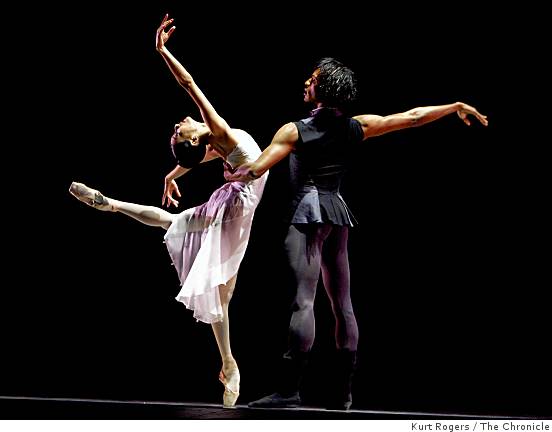 Imaginings in mauve
Imaginings in mauve
Lilacs with their heavy, mothlike blossoms, lavender colors and thick sweet fragrance. Lilacs, a cold weather flower: if you leave Moscow for San Francisco, you leave them behind.
Lilacs can hang in the memory, though, a souvenir of youth with the promise of warm days and love. And as such they are the central image of Diving Into the Lilacs, the romantic and miraculously lovely ballet by choreographer Yuri Possokhov that opened the SF Ballet season on Tuesday night.
Possokhov places lilacs at the back of a darkened stage, in a tableau of blossoms surrounded by blackness, and, with each movement of Boris Tchaikovsky’s Symphonietta for String Orchestra, they multiply in lushness, moving from the shadowy light of winter to the full color and splendor of early summer.
The ensemble moves before this changing floral composition, the women trailing gauzy skirts of mauve, in sync with pizzicato strings. Couples rise from the ground as if they were the first buds breaking through the skin of a branch. And solitary dancers roll into each other, curving body against curving body. They cluster like panicles, floral and elusive.
Through the allegro second movement, Pascal Molat waltzes with the truly sylphlike Maria Kochetkova, embodying the essence of dance, with its off-kilter momentum, its surrender to lightness. The dancers run, skip. A foot flexes. Like fallen blossoms, the women are left dropped to the floor.
The adagio third movement is sweetly romantic. An exultant male leaps into a knot of women, as if plunging into lilacs, sprung up from collapse. Yuan Yuan Tan and Anthony Spaulding execute an adagio with flashing grace. Male and female weave into each other.
A rondo, led by the rapturous Lorena Feijoo and Joan Boada, closes the world premiere of Possokhov’s Diving Into the Lilacs.
Possokhov has been the company’s choreographer in residence since 2006. Trained in Moscow and dancing with the Bolshoi for ten years, he brings to the company a deep-in-the-marrow-of-the-bones understanding of classical ballet. But his choreographic sense is also completely contemporary, aware of and working in sync with gravity as a force on the body. Here and there, the signature movements of modern dance decorate the movements’ ebb and flow. But the forces contained within Possokhov’s choreography are also less aggressive than many contemporary choreographers’ and, in that way, less affected. He is really an excellent choreographer for this talented and skilled company, bringing fresh ideas that remain true to his very personal and emotive vision.
On either side of Diving Into the Lilacs were two neoclassical ballets, both choreographed for the New York City Ballet: Helgi Tomasson’s Prism and George Balanchine’s seminal work, The Four Temperaments.
From the instant the couple in dance studio garb—she in black leotard and pink tights, he in white T-shirt and black tights—cross arms and legs, you know you’re in Balanchine Land. Precise patterning that shows off every line of the dancer’s carefully developed body, intricate structures of movement that shift seamlessly from symmetrical to asymmetrical, partnering that never seems like partnering, short improbable lifts, winding ensembles. It’s all there, and it’s gorgeous.
Helgi Tomasson’s well-crafted and technically challenging but rather uninspiring Prism opened this concert. But Possokhov’s and Balanchine’s masterworks made it all worth while.
—Jaime Robles
Originally published in the Piedmont Post
Photo: Yuan Yuan Tan and Anthony Spaulding by Kurt Rogers
